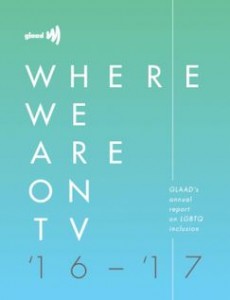 NEW YORK – GLAAD today released its annual Where We Are on TV report. Where We Are on TV analyzes the overall diversity of primetime scripted series regulars on broadcast networks and assesses the number of LGBTQ characters on cable networks and streaming services for the 2016-2017 TV season. This marks the 21st year that GLAAD has tracked the presence of LGBTQ characters on television.
NEW YORK – GLAAD today released its annual Where We Are on TV report. Where We Are on TV analyzes the overall diversity of primetime scripted series regulars on broadcast networks and assesses the number of LGBTQ characters on cable networks and streaming services for the 2016-2017 TV season. This marks the 21st year that GLAAD has tracked the presence of LGBTQ characters on television.
The report found the highest percentage (4.8%) of LGBTQ regular characters on broadcast television since GLAAD began tracking all broadcast regular characters 12 years ago. Other encouraging findings include a record-high percentage of black series regular characters on broadcast television (20% of all series regulars) and a record-high percentage of regular characters with disabilities on broadcast television (1.7%). Additionally, the number of transgender regular and recurring characters has more than doubled since last year (from 7 on all platforms to 16 this year). Last year, there were no trans characters counted on broadcast.
“While it is heartening to see progress being made in LGBTQ representation on television, it’s important to remember that numbers are only part of the story, and we must continue the push for more diverse and intricate portrayals of the LGBTQ community,” said Sarah Kate Ellis, GLAAD President & CEO. “GLAAD will continue to work with Hollywood to tell nuanced LGBTQ stories that accelerate acceptance – and hold the networks, streaming services, and content creators accountable for the images and storylines they present.”
While much improvement has been made and TV remains far ahead of film in terms of LGBTQ representation, it must be noted that television – and broadcast series more specifically – failed queer women this year, as character after character died, continuing the harmful ‘bury your gays’ trope. Over 25 lesbian and bisexual female-identifying characters have died on scripted television and streaming series since the beginning of 2016. This comes after last year’s report called on broadcast content creators to do better by lesbian and bisexual women after many superfluous deaths. It continues a decades-long trend of killing LGBTQ characters – often solely to further a straight, cisgender character’s plotline – which sends a dangerous message to audiences that LGBTQ people are secondary and disposable. It is important that creators do not reinvigorate harmful tropes, which exploit an already marginalized community.
Additional findings include:
- Each platform tracked (broadcast, cable, streaming) counts one character who is HIV-positive, though only broadcast television counts the character as a series regular (Oliver on ABC’s How to Get Away with Murder).
- Cable and streaming platforms still need to include more racially diverse LGBTQ characters as a majority of LGBTQ characters on each platform (72% and 71% respectively) are counted as white.
- While this year marks the highest percentage of primetime broadcast regulars who are black, black women remain underrepresented at only 38% of all black series regulars.
- Bisexual representation on broadcast television rose to 30%, up from 20% on last year’s report. However, the representation skews largely female, with 16 women and only five men.
GLAAD’s Spanish-language media report, Nearly Invisible, will be released in November. Additionally, the Studio Responsibility Index will be released in early 2017. GLAAD uses the data from these reports to create a clearer picture of the stories and portrayals of LGBTQ people being presented by the media and encourage networks and studios alike to include more diverse LGBT representations that accelerate acceptance.











